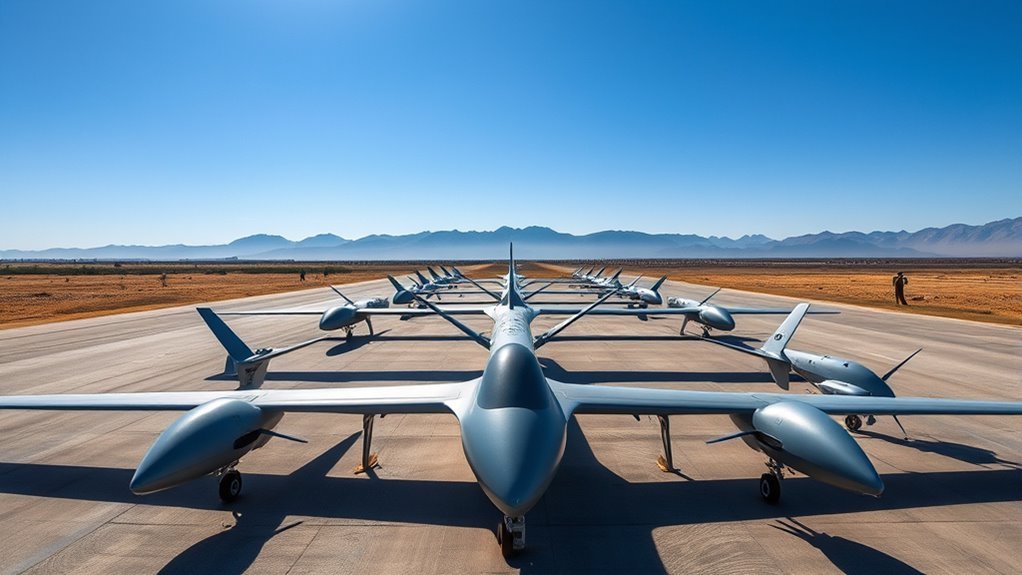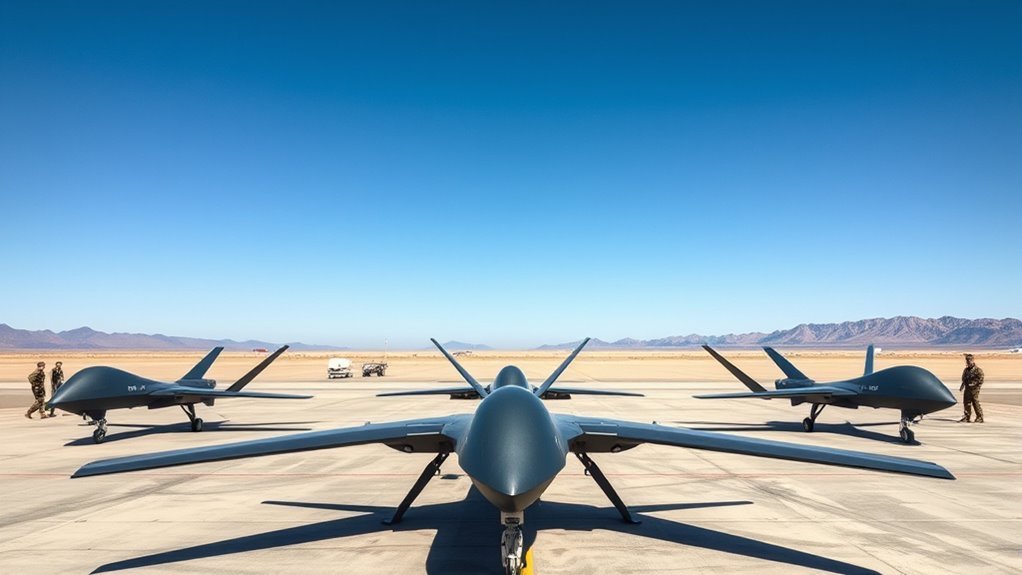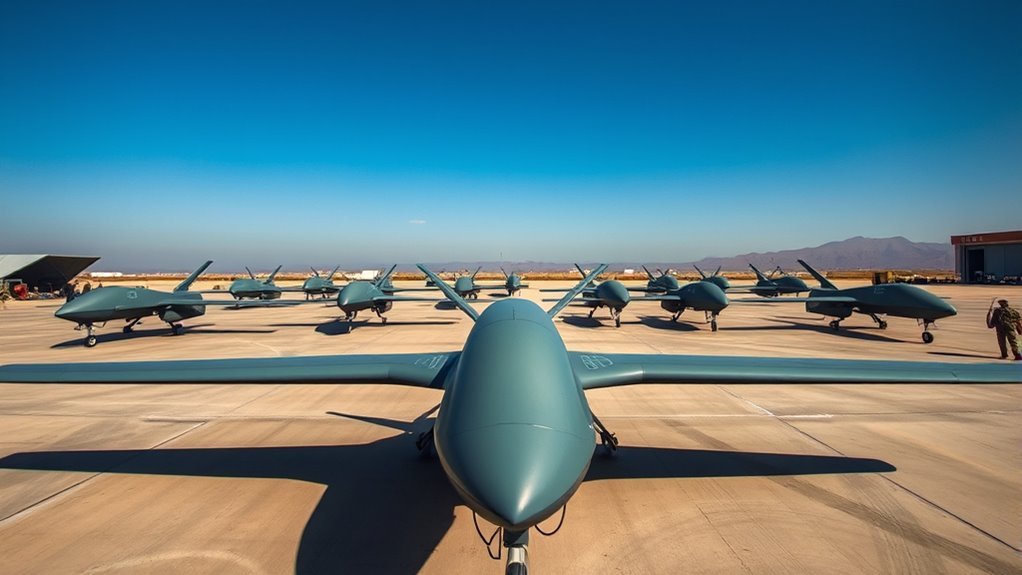Pakistan has developed an extensive drone program with a significant military inventory, consisting of various unmanned aerial vehicles tailored for surveillance and combat. While exact numbers are not publicly disclosed, the fleet includes advanced reconnaissance drones, combat drones, and adapted commercial models. This diverse array enhances operational efficiency. If you explore further, you’ll uncover insights into indigenous development, foreign procurement, and the strategic importance of drones in Pakistan’s defense landscape.
Overview of Pakistan’s Drone Program

Although Pakistan’s drone program is often overshadowed by larger military powers, it has developed a range of unmanned aerial vehicles (UAVs) that reflect its strategic aspirations. The program emphasizes military collaboration, both domestically and with international partners, enhancing its technological capabilities. However, the advancement of this program raises important considerations regarding drone regulations. Effective regulations are vital for ensuring the responsible use of UAVs, balancing national security interests with human rights and ethical concerns. As you explore Pakistan’s drone capabilities, it is imperative to recognize the implications of its military strategies and the need for transparent governance. This understanding will allow you to appreciate the complexities surrounding Pakistan’s drone program within the broader context of global military dynamics and technological innovation.
Types of Drones in Pakistan’s Inventory

Pakistan’s drone inventory showcases a diverse array of unmanned aerial vehicles designed for various military and surveillance purposes. Among these, you’ll find advanced reconnaissance drones equipped with high-resolution cameras, enhancing surveillance capabilities in challenging terrains. Additionally, the inventory includes commercial drones, which have been adapted for military use, reflecting a pragmatic approach to technology integration. These commercial drones offer cost-effective solutions for aerial monitoring and intelligence gathering. Furthermore, specialized combat drones are also part of the inventory, providing tactical advantages during operations. Each type of drone serves a distinct role, collectively bolstering Pakistan’s operational efficiency and strategic reach. The ongoing evolution of these technologies signifies a commitment to enhancing national security while adapting to modern warfare needs.
Indigenous Drone Development

As the demand for advanced aerial capabilities grows, indigenous drone development in Pakistan has gained significant momentum. You’ll find that this push reflects a commitment to indigenous innovation, allowing the country to reduce reliance on foreign technology. Pakistan has invested in drone manufacturing facilities that focus on creating unmanned aerial vehicles tailored to its unique operational needs. These developments not only enhance military capabilities but also promote self-sufficiency in defense. The emphasis on local expertise fosters a culture of technological advancement and innovation. By cultivating a robust drone manufacturing sector, Pakistan aims to strengthen its position in the regional power dynamics while ensuring operational readiness for future challenges. Overall, indigenous drone development represents a critical step toward greater autonomy in defense technology.
Procurement of Foreign Drones
While indigenous drone development has made significant strides, the procurement of foreign drones remains an important strategy for Pakistan to enhance its aerial capabilities. By engaging in foreign procurement, Pakistan can access advanced technologies and operational frameworks that may not be fully developed domestically. This strategy often involves forming defense partnerships with countries that possess sophisticated drone systems, enabling Pakistan to bolster its military effectiveness without the lengthy timeline of homegrown projects. Such collaborations can provide not just hardware, but also essential training and support. These partnerships, thus, represent an essential avenue for Pakistan in traversing the complex landscape of modern warfare, ensuring it remains competitive and secure while working for greater autonomy in defense capabilities.
Operational Uses of Drones
Drones have become a pivotal asset in modern military operations, serving various roles that enhance both strategic and tactical effectiveness. Their operational uses are diverse, particularly in drone surveillance and combat operations. In surveillance, drones provide real-time intelligence, allowing you to monitor enemy movements and gather valuable data without putting personnel at risk. This capability enhances decision-making and situational awareness on the battlefield. In combat operations, drones can engage targets directly, delivering precision strikes with minimal collateral damage. By integrating drones into military strategies, you can achieve objectives more efficiently, reducing the need for ground forces in hostile environments. Overall, the operational versatility of drones considerably transforms how military forces approach and execute their missions.
Strategic Importance of Drones in Defense
The growing reliance on drones in military operations underscores their strategic importance in defense. Drones provide several tactical advantages that enhance operational effectiveness and decision-making. Here are some key aspects to evaluate:
- Cost-Effectiveness: Drones are generally cheaper to operate than traditional manned aircraft.
- Real-Time Data: They offer immediate reconnaissance capabilities, allowing for swift assessments of battlefield conditions.
- Reduced Risk: By deploying drones, militaries can minimize the risk to human life in dangerous missions.
- Versatile Applications: Drones can be utilized for intelligence gathering, surveillance, and even targeted strikes, adapting to various mission requirements.
Incorporating drones into defense strategies not only improves operational efficiency but also aligns with a growing need for innovative approaches to modern warfare.
Challenges and Limitations
When evaluating Pakistan’s drone capabilities, you’ll encounter several challenges and limitations. Technological constraints often hinder the development and deployment of advanced systems, while operational challenges can affect their effectiveness in various environments. Understanding these factors is essential for evaluating the overall impact of drones on Pakistan’s defense strategy.
Technological Constraints
Although Pakistan has made significant strides in its drone capabilities, it still faces several technological constraints that hinder its operational effectiveness. These constraints limit the military applications of its drones and affect its overall strategic objectives. Here are some critical challenges:
- Limited indigenous production: Dependence on foreign technology restricts advancements.
- Sensor technology: Inadequate surveillance and reconnaissance capabilities affect mission success.
- Data processing: Challenges in real-time data analysis hinder decision-making during operations.
- Payload capacity: Insufficient payload limits the versatility and effectiveness of military missions.
Addressing these technological advancements is essential for enhancing operational capabilities and ensuring Pakistan’s drones can compete effectively on the global stage.
Operational Challenges
While Pakistan’s drone capabilities have evolved, several operational challenges persist that undermine their effectiveness in military engagements. One significant issue is the limited surveillance capabilities of certain drone models, which can hinder real-time intelligence gathering. This lack of advanced sensors may restrict the ability to conduct precise strikes or monitor hostile activities effectively. Additionally, operational efficiency can be compromised by logistical constraints, such as maintenance and training requirements. These factors not only affect mission success but also lead to increased vulnerability in high-stakes situations. Moreover, the integration of drones into existing military frameworks remains a complex challenge, often resulting in delays and operational inconsistencies. Addressing these challenges is vital for maximizing the potential of Pakistan’s drone fleet.
Future Prospects for Drone Technology in Pakistan
As drone technology continues to evolve globally, Pakistan stands at a pivotal juncture where the potential for advancement in this sector could significantly impact various industries. You might consider the following future trends and potential innovations:
- Enhanced Surveillance Capabilities: Improved sensors and AI integration for real-time data collection.
- Agricultural Applications: Drones could revolutionize farming through precision agriculture and resource management.
- Disaster Response: Increased use of drones for rapid assessment and aid delivery in emergencies.
- Commercial Development: Opportunities for local startups to innovate and expand drone services.
Moreover, the integration of AI-driven analytics in drone operations could enhance data processing efficiency and inform strategic decisions in environmental management.
Frequently Asked Questions
What Are the Key Features of Pakistan’s Drone Technology?
You’d think Pakistan’s drones were designed for a sci-fi movie! In reality, their drone capabilities showcase significant technological advancements, featuring surveillance, precision strikes, and enhanced communication systems, reflecting a growing prowess in modern military strategy.
How Does Pakistan’s Drone Inventory Compare to Neighboring Countries?
When you analyze Pakistan’s drone capabilities, they’re substantial but vary compared to neighbors. Military comparisons show India and China possess more advanced technology, influencing regional dynamics and highlighting Pakistan’s focus on enhancing its drone inventory.
What Role Do Drones Play in Counter-Terrorism Efforts?
Imagine a hawk soaring above, eyes sharp. Drones, like that hawk, provide essential surveillance in counter-terrorism. They enhance military strategy, offering precise intelligence and targeting capabilities, ultimately safeguarding freedom while minimizing collateral damage in conflict zones.
Are There Any International Regulations Affecting Pakistan’s Drone Usage?
Yes, there’re international regulations and treaties governing drone usage. Pakistan must navigate these frameworks to guarantee compliance, balancing its national security interests with global norms aimed at promoting responsible drone operations and minimizing potential conflicts.
How Has Public Perception of Drones Evolved in Pakistan?
Public perception of drones in Pakistan’s shifted dramatically; initially viewed as protective, now, influenced by media portrayal, many question their effectiveness and ethical implications, revealing a complex relationship between technology, freedom, and national security.

